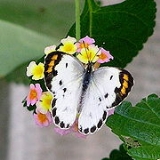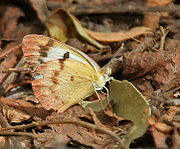
Colotis etrida
Encyclopedia
Small Orange-Tip , Colotis etrida is a small butterfly
of the Family
Pieridae
, that is, the Yellows and Whites, which is found in India
.
_in_hyderabad,_ap_w_img_7113.jpg) The ground colour on the upperside of the males is white, sparsely irrorated at base of fore and hind wings with black scales. Fore wing has a small black spot on the discocellulars ; apex broadly black, with an enclosed oval, curved, rich orange patch placed obliquely and traversed by the veins, which there are black ; inner edge of black area diffuse. Hind wing is uniform, except for a preapical short diffuse black streak from the costa, sometimes absent, and a series of terminal black spots that in specimens from moist localities are very large. Underside is white with the cell and apex of fore wing suffused with sulphur-yellow, the orange patch of the upperside shows through
The ground colour on the upperside of the males is white, sparsely irrorated at base of fore and hind wings with black scales. Fore wing has a small black spot on the discocellulars ; apex broadly black, with an enclosed oval, curved, rich orange patch placed obliquely and traversed by the veins, which there are black ; inner edge of black area diffuse. Hind wing is uniform, except for a preapical short diffuse black streak from the costa, sometimes absent, and a series of terminal black spots that in specimens from moist localities are very large. Underside is white with the cell and apex of fore wing suffused with sulphur-yellow, the orange patch of the upperside shows through
by transparency, its inner edge margined anteriorly by a very obscure oblique fuscous band. Hind wing has the preapical short transverse black streak on the upperside obscurely indicated.

 The female is very similar to the male but can be distinguished as follows :
The female is very similar to the male but can be distinguished as follows :
Upperside of fore wing has a narrower orange patch enclosed within the black
apical area; a small black spot in middle of interspace 1 and another in interspace 3. Hind wing has the terminal spots slightly larger.
On the underside the apex of fore and whole surface of hind wing suffused lightly, or in specimens from very dry localities heavily, with ochraceous. Fore wing has spots in interspaces 1 and 3 as on the upperside. Hind wing : a curved, almost complete,
discal series of fuscous spots ; otherwise as in the male.
In both sexes the antennae vary from white to pale brownish ; head, thorax and abdomen black, the head and thorax with short greyish-brown hairs ; beneath : the palpi, thorax and abdomen white.
Found from the outer ranges of the Himalayas throughout peninsular India except Bengal.
Race limbata is found in Sri Lanka. and it has the black apical area on fore wing darker, broader, occupying about a third of the wing ; the orange patch enclosed within
it is proportionately narrower, so that the black on its inner margin has the appearance of being broader proportionately than it is in the typical form. Very often this inner edge is bordered by a suffusion of sulphur-yellow. Specimens from south Indian hills resemble this closely.
It has the curious habit of resting with the anal segment not attached to a twig." {Davidson MS. Extract from de Niceville's MS. of the Pierin, Butt, of Ind.)
Butterfly
A butterfly is a mainly day-flying insect of the order Lepidoptera, which includes the butterflies and moths. Like other holometabolous insects, the butterfly's life cycle consists of four parts: egg, larva, pupa and adult. Most species are diurnal. Butterflies have large, often brightly coloured...
of the Family
Family
In human context, a family is a group of people affiliated by consanguinity, affinity, or co-residence. In most societies it is the principal institution for the socialization of children...
Pieridae
Pieridae
The Pieridae are a large family of butterflies with about 76 genera containing approximately 1,100 species, mostly from tropical Africa and Asia. Most pierid butterflies are white, yellow or orange in coloration, often with black spots...
, that is, the Yellows and Whites, which is found in India
India
India , officially the Republic of India , is a country in South Asia. It is the seventh-largest country by geographical area, the second-most populous country with over 1.2 billion people, and the most populous democracy in the world...
.
Description
- See glossaryGlossary of Lepidopteran termsThis glossary describes the terms used in the formal descriptions of insect species, jargon used mostly by professionals or entomologist....
for terms used
_in_hyderabad,_ap_w_img_7113.jpg)
by transparency, its inner edge margined anteriorly by a very obscure oblique fuscous band. Hind wing has the preapical short transverse black streak on the upperside obscurely indicated.


Upperside of fore wing has a narrower orange patch enclosed within the black
apical area; a small black spot in middle of interspace 1 and another in interspace 3. Hind wing has the terminal spots slightly larger.
On the underside the apex of fore and whole surface of hind wing suffused lightly, or in specimens from very dry localities heavily, with ochraceous. Fore wing has spots in interspaces 1 and 3 as on the upperside. Hind wing : a curved, almost complete,
discal series of fuscous spots ; otherwise as in the male.
In both sexes the antennae vary from white to pale brownish ; head, thorax and abdomen black, the head and thorax with short greyish-brown hairs ; beneath : the palpi, thorax and abdomen white.
Found from the outer ranges of the Himalayas throughout peninsular India except Bengal.
Race limbata is found in Sri Lanka. and it has the black apical area on fore wing darker, broader, occupying about a third of the wing ; the orange patch enclosed within
it is proportionately narrower, so that the black on its inner margin has the appearance of being broader proportionately than it is in the typical form. Very often this inner edge is bordered by a suffusion of sulphur-yellow. Specimens from south Indian hills resemble this closely.
Larva
"Much resembles that of a moth caterpillar, being very narrow, the anal segment much prolonged ; colour uniform green, with a narrow line along each side just above the roots of the legs, sometimes broader, sometimes yellow, sometimes pinkish -white.It has the curious habit of resting with the anal segment not attached to a twig." {Davidson MS. Extract from de Niceville's MS. of the Pierin, Butt, of Ind.)
Pupa
"Compressed, the snout much prolonged and turned upwards. At first it is greenish, but afterwards becomes a greyish white, beautifully marbled with brown." {Idem.}See also
- PieridaePieridaeThe Pieridae are a large family of butterflies with about 76 genera containing approximately 1,100 species, mostly from tropical Africa and Asia. Most pierid butterflies are white, yellow or orange in coloration, often with black spots...
- List of butterflies of India
- List of butterflies of India (Pieridae)

